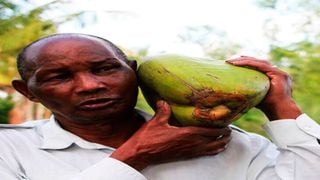
Richard Kuisya at his coconut farm in Kaiti village, Makueni County. He grows coconut palms alongside bananas, beans, mangoes, maize, and oranges.
| Pius Maundu | Nation Media GroupSeeds of Gold
Premium
My 100 coconut palms thrive in dry Ukambani
What you need to know:
- The coconut palms have been a major source of livelihood for Wote farmer Richard Kuisya.
- The farmer also keeps dairy cows and supplies the milk from six animals at Makueni Dairy in Wote town.
Towering other plants at Richard Kuisya's farm in Kaiti village, Wote, Makueni County, are coconut palms whose fronds make a beautiful whispering sound when the wind blows.
The mature trees stand out in the countryside where locals only know of the ornamental dwarf palms used in landscaping palatial homesteads.
The coconut palms have been a major source of livelihood for Kuisya.
"My three acres hold 100 coconut palms. The oldest is 34 years while the youngest is eight,” he tells Seeds of Gold team.
He grows the East African Tall Coconut palms, which dwarf the mango trees dotting many farms in the area.
Most of the palms are heavy with fruits, shattering the age-old stereotype that coconut palms thrive only at the Coast.
Coconuts thrive in areas where the altitude is below 600 metres above sea level, according to scientists at Kenya Agriculture and Livestock Research Organisation. The areas should have moderate rainfall and a temperature of between 24-300C.
Although coconuts do well in sandy and water-logged soils, well-drained loam or clay soils are the best. This means semi-arid counties are an ideal place for growing coconut palms.

Baha Nguma, an agriculturist who focuses on coconut husbandry, says the cash crop does well in dry parts of Embu, Kitui, Machakos, Makueni, Meru, Nyeri and Tharaka Nithi counties, but farmers need to find out their commercial value first before growing the trees.
They are propagated either directly on the seedbed or in a nursery. Kuisya, who taught himself coconut palms nursery management, establishes seeds in a nursery first before transplanting the seedlings into zai pits measuring 60cm3.
Agronomists recommend that the mother plant should be more than 30 years for the seeds to be viable.
“A very high degree of patience is required at the nursery stage because coconut seeds take nine months to sprout,” Kuisya says.
He prefers transplanting them shortly before the short rains start to minimise watering.
Although coconut palms are rarely attacked by pests and diseases, they must be weeded regularly for good growth.
“A coconut palm starts producing fruits from 5-7 years and can continue producing until its 100 years old,” says Nguma, who works with Food and Agriculture Organisation of the United Nations.
However, there are fast-maturing coconut varieties which farmers are set to start growing. The government imported from India and they start producing fruits after 3-4 years.
Coconut seedling
Kuisya, 72, and a father of eight intercrops the coconut palms with bananas, oranges, pawpaws, maize and beans.
“I sell coconut palm seedlings at Sh500 each to those growing them for ornamental purposes, a coconut fruit at Sh50 and a broom Sh50. I don’t harvest palm wine because it is against my faith and I don’t make roofing materials from the dry fronts because they have no market locally,” he says.
The farmer also keeps dairy cows and supplies the milk from six animals at Makueni Dairy in Wote town.
He has been farming for years, growing a variety of crops that include onions, sorghum, millet and once experimented with sugarcane.
While attending a workshop for a Catholic Church programme that saw hundreds of farmers trained on the need to install terraces and grow drought-tolerant crops such as sorghum and millet in 1986, Kuisya collected a coconut seedling and took it home with him.
To his surprise, the seedling thrived into a beautiful palm, motivating him to plant more.
The fortunes of coconut framers are set to improve after the main-streaming of the hybrid varieties from India, which produce 200-250 fruits annually. The early maturing variety, according to Nguma, was seeded in Kwale County three years ago from where it will be distributed in other coconut producing zones across the country.





